Demographics of Sarajevo
The population of the city of Sarajevo's four municipalities is 275.524, whereas the Sarajevo Canton population is estimated at 413.593.[1]
Ethnic composition by municipalities, 2013 census
| Ethnic composition of Sarajevo, by municipalities, 2013 census | ||||||
| municipality | total | Bosniaks | Serbs | Croats | others | |
| Centar | 55,181 | 41,702 (75.57%) | 2,186 (3.96%) | 3,333 (6.04%) | 7,960 (14.42%) | |
| Novi Grad | 118,553 | 99,773 (84.16%) | 4,367 (3.68%) | 4,947 (4.17%) | 9,466 (7.98%) | |
| Novo Sarajevo | 64,814 | 48,188 (74.35%) | 3,402 (5.25%) | 4,639 (7.16%) | 8,585 (13.24%) | |
| Stari Grad | 36,976 | 32,794 (88.69%) | 467 (1.3%) | 685 (1.85%) | 3,030 (8.19%) | |
| total | 275,524 | 222,457 (80.74%) | 10,422 (3.78%) | 13,604 (4.94%) | 29,041 (10.54%) | |
1991 census
- Sarajevo (five municipalities: Centar, Novi Grad, Novo Sarajevo, Ilidža and Stari Grad)
total: 361,735
- The greater area of Sarajevo (ten municipalities: Centar, Ilidža, Hadžići, Ilijaš, Novi Grad, Novo Sarajevo, Pale, Stari Grad, Trnovo and Vogošća)
total: 527,049
Ethnic composition by municipalities, 1991 census
| Ethnic composition of Sarajevo, by municipalities, 1991. census | ||||||
| municipality | total | ethnic Muslims (modern Bosniaks) | Serbs | Yugoslavs | Croats | others |
| Centar | 79,286 | 39,761 (50.14%) | 16,631 (20.97%) | 13,030 (16.43%) | 5,428 (6.84%) | 4,436 (5.59%) |
| Novi Grad | 136,616 | 69,430 (50.82%) | 37,591 (27.51%) | 15,580 (11.40%) | 8,889 (6.50%) | 5,126 (3.75%) |
| Novo Sarajevo | 95,089 | 33,902 (35.65%) | 32,899 (34.59%) | 15,099 (15.87%) | 8,798 (9.25%) | 4,391 (4.61%) |
| Stari Grad | 50,744 | 39,410 (77.66%) | 5,150 (10.14%) | 3,374 (6.64%) | 1,126 (2.21%) | 1,684 (3.31%) |
| total | 361,735 | 182,503 (50.45%) | 92,271 (25.50%) | 47,083 (13.01%) | 24,241 (6.70%) | 15,637 (4.32%) |
| Ethnic composition of Sarajevo Canton, by municipalities, 1991. census | ||||||
| municipality | total | ethnic Muslims (modern Bosniaks) | Serbs | Yugoslavs | Croats | others |
| Centar | 79,286 | 39,761 (50.14%) | 16,631 (20.97%) | 13,030 (16.43%) | 5,428 (6.84%) | 4,436 (5.59%) |
| Hadžići | 24,200 | 15,392 (63.60%) | 6,362 (26.28%) | 841 (3.47%) | 746 (3.08%) | 859 (3.54%) |
| Ilidža | 67,937 | 29,337 (43.18%) | 25,029 (36.84%) | 5,181 (7.62%) | 6,934 (10.20%) | 1,456 (2.14%) |
| Ilijaš | 25,184 | 10,585 (42.03%) | 11,325 (44.96%) | 1,167 (4.63%) | 1,736 (6.89%) | 371 (1.47%) |
| Novi Grad | 136,616 | 69,430 (50.82%) | 37,591 (27.51%) | 15,580 (11.40%) | 8,889 (6.50%) | 5,126 (3.75%) |
| Novo Sarajevo | 95,089 | 33,902 (35.65%) | 32,899 (34.59%) | 15,099 (15.87%) | 8,798 (9.25%) | 4,391 (4.61%) |
| Pale | 16,355 | 4,364 (26.68%) | 11,284 (68.99%) | 396 (2.42%) | 129 (0.78%) | 182 (1.11%) |
| Stari Grad | 50,744 | 39,410 (77.66%) | 5,150 (10.14%) | 3,374 (6.64%) | 1,126 (2.21%) | 1,684 (3.31%) |
| Trnovo | 6,991 | 4,790 (68.81%) | 2,059 (29.45%) | 72 (1.02%) | 16 (0.22%) | 54 (0.77%) |
| Vogošća | 24,647 | 12,499 (50.71%) | 8,813 (35.75%) | 1,730 (7.01%) | 1,071 (4.34%) | 534 (2.16%) |
| total | 527,049 | 259,470 (49.23%) | 157,143 (29.81%) | 56,470 (10.71%) | 34,873 (6.61%) | 19,093 (3.62%) |
Historical population
Historically Sarajevo had always been a very populous city, but as the Ottoman Empire declined, so did its population. Although it had around 100,000 people in the 1660s, by the end of World War II in the 1940s Sarajevo had only grown to some 115,000 people.
The population of the district of Sarajevo, according to the 1921 Kingdom of Serbs, Croats and Slovenes religious population census:
- Serbian Orthodox Christians 55,477 (38.6%)
- Sunni Muslims 50,270 (34.9%)
- Roman Catholic Christians 29,395 (20.4%)
- Others 8,768 (6.1%)
In 1921 there were 8 municipalities, and their populations were:
- Serbs comprised majorities in 5 municipalities: Ilidža, Koševo, Pale, Rajlovac, and Trnovo.
- Bosniaks comprised majorities in the City of Sarajevo and in 2 municipalities: Bjelašnica and Ozren.
The same year, the City of Sarajevo had 78,173 inhabitants:
- Sunni Muslims 29,649 (37.9%)
- Roman Catholic Christians 21,373 (27.3%)
- Serbian Orthodox Christians 18,630 (23.8%)
- Others 8,522 (11.0%)
Heavy industrialization and increased importance in regional affairs during the time of Yugoslavia resulted in a rapid increase, however, and by the time of the 1984 Olympics, the greater Sarajevo area had more than 500,000 residents. Although exact ethnic distribution is unknown, of these 500,000, 49% were Muslim, 30% Orthodox Christians, and 7% Catholics, indicating relatively corresponding percentages of Bosniaks, Serbs, and Croats.
The Yugoslav wars and the resulting siege of Sarajevo radically disrupted this order of things. The city itself was completely surrounded by Bosnian Serb forces, and it has been estimated that some 12,000 people were killed, with another 50,000 wounded. Combined with horrific living conditions forced upon by the besieging forces, the result was thousands of refugees leaving the city. By 1996, Sarajevo had less than 300,000 residents. The majority Sarajevan Serbs, massively fled the Bosnian capital, with their fears fuelled by propaganda, rumors and mass panic. Early estimates stated 62,000 Serbs leaving Sarajevo,[2] In the years that followed, a tremendous influx of returning refugees and people from a war-torn countryside resulted in the city population once again going above 300,000 residents.[3]
The following are some recorded populations of Sarajevo throughout its history. The figures from 1580 and 1800 are from.[4] The figures from 1626 and 1660 are based on the accounts of traveling writers who estimated that Sarajevo at the time had 20,000 houses, and figures an average of 5 people per house. All latter figures are based on official censuses by Austria-Hungary, the Kingdom of Yugoslavia, and Socialist Yugoslavia, except for that of 2002, which is an estimate by the Sarajevo Canton government. All figures after 1945 represent the greater Sarajevo area.
| Year | Population |
|---|---|
| 1580 | 40,000 |
| 1626 | more than 60,000 |
| 1660 | more than 100,000 |
| 1800 | between 40,000 and 45,000 |
| 1910 | 51,919 |
| 1921 | 66,317 |
| 1931 | 78,173 |
| 1945 | 115,000 |
| 1971 | 359,448 |
| 1991 | 527,049 |
| 2002 | 401,118 |
Population density
According to the official government statistics, Sarajevo's population density is 2470.1 per square kilometer. The most densely populated part of Sarajevo is in the municipality Novo Sarajevo (7524.5 inhabitants per square kilometer), while the least densely populated is the Stari Grad municipality (742.5 inhabitants per square kilometer).
Age
Regarding the age structure of Sarajevo, the overwhelming majority of people are between 15 and 64 years of age. This group consists of 208,703 people, a little over 70% of the total city population. When it comes to people 14 years of age or under and people over 65 years of age, the youth have a slight edge. There are 47,558 people under 14 years of age in Sarajevo, making up 16% of the overall population, compared to 41,138 people over 65 years of age, who make up 13.8% of the total population. The Novi Grad municipality has the highest percentage of citizens under 14 years of age in the city, at 17.4%, while 17.5% of Novo Sarajevo municipality's population is over 65 years of age. Overall, the city's population is slightly older than its surrounding areas and the Federation of Bosnia and Herzegovina as a whole.
Ethnic groups
The biggest ethnic group in Sarajevo are the Bosniaks who, with more than 230,000 people, make up 77.4% of the city. They are followed by the Serbs, of which there are some 35,000 (12% of the city), and Croats with a population of 22,380 (7.5% of the total population). 9,283 people (3.1% of the overall population) are classified as others. They most likely consist of Sephardi Jews, and Romani, along with a small number of foreign workers and also Bosnians who come from mixed marriages and do not take either side as their own, other than simply 'others' or Bosnians.
Birth rate
The city's birth rate is 9.17 while the mortality is 8.10, resulting in a population growth rate of 1.07. The greater Sarajevo area, meanwhile, has a 9.56 birth rate and 8.01 mortality rate, which makes for a population growth rate of about 1.55. This would indicate a population of 303,797 in the city by December 2004, and a population of 413,649 in the metropolitan area. If current growth trends continue, the city's population should reach the pre-war population in less than 25 years. The metro area would do the same a bit sooner, in some 15 years.
Ethnic maps
- 1961–1981 censuses
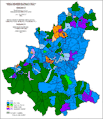 Ethnic structure of Sarajevo by settlements 1961
Ethnic structure of Sarajevo by settlements 1961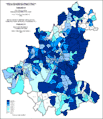 Share of Serbs in Sarajevo by settlements 1961
Share of Serbs in Sarajevo by settlements 1961 Ethnic structure of Sarajevo by settlements 1971
Ethnic structure of Sarajevo by settlements 1971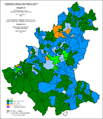 Ethnic structure of Sarajevo by settlements 1981
Ethnic structure of Sarajevo by settlements 1981
- 1991 census
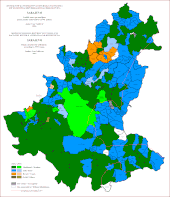 Ethnic structure of Sarajevo by settlements 1991
Ethnic structure of Sarajevo by settlements 1991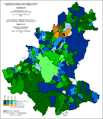 Ethnic structure of Sarajevo by settlements 1991
Ethnic structure of Sarajevo by settlements 1991 Share of ethnic Muslims in Sarajevo by settlements 1991
Share of ethnic Muslims in Sarajevo by settlements 1991 Share of Serbs in Sarajevo by settlements 1991
Share of Serbs in Sarajevo by settlements 1991 Share of Croats in Sarajevo by settlements 1991
Share of Croats in Sarajevo by settlements 1991
- 2013 census
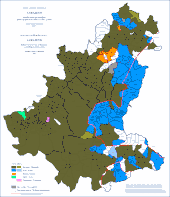 Ethnic structure of Sarajevo by settlements 2013
Ethnic structure of Sarajevo by settlements 2013 Ethnic structure of Sarajevo by settlements 2013
Ethnic structure of Sarajevo by settlements 2013 Share of Bosniaks in Sarajevo by settlements 2013
Share of Bosniaks in Sarajevo by settlements 2013 Share of Serbs in Sarajevo by settlements 2013
Share of Serbs in Sarajevo by settlements 2013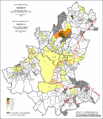 Share of Croats in Sarajevo by settlements 2013
Share of Croats in Sarajevo by settlements 2013
References
- "Data". www.popis2013.ba.
- McEvoy & O'Leary 2013, p. 345:"On the other hand, Dayton's ethnic circumscription of space after the war had detrimental effects on Sarajevo, catalyzing a mass exodus in early 1996 of some sixty-two thousand Sarajevo Serbs from inside what would be the Dayton borders of Sarajevo city and its suburbs and creating today's more monoethnic postwar city (Internal Displacement Monitoring Centre 1996)."
- The 2013 population census in Bosnia and Herzegovina states that 10,422 (3.78% of the total population of the Sarajevo canton) Serbs were living at the time inside the Sarajevo canton, a part of 92,271 (25.50% of the canton's pre-war population), which may have been Serbs having returned after the war, or who never left. Note that 47,083 (13.01% of the canton's population) Yugoslavs (an often self-applied term for people of mixed ethnicities) also lived in the Sarajevo canton as of 1991. There is no data regarding their number from 2013 Bosnia and Herzegovina population census.
- H. Inalcık, An Economic and Social History of the Ottoman Empire, Cambridge University press, 1994
Bibliography
- Ethnic composition of Bosnia-Herzegovina population, by municipalities and settlements, 1991. Census, Zavod za statistiku Bosne i Hercegovine – Bilten no. 234, Sarajevo. 1991.